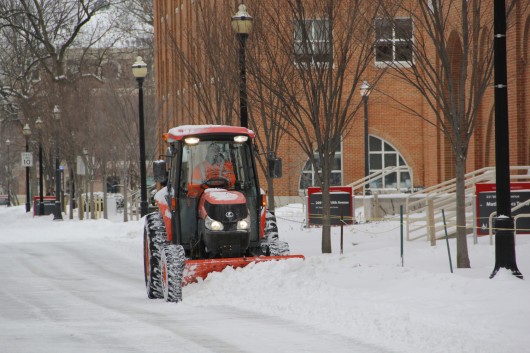
A snow plow drives through campus to clear the road Jan. 26. Classes were canceled at OSU’s Columbus campus Jan. 28.
Credit: Lantern file photo
Ohio State students who live in off-campus housing will have a better understanding of Columbus’ strategy for plowing roads during heavy snowstorms this winter season.
The Department of Public Service has launched a new website, warriorwatch.columbus.gov, that aims to provide information about street priority and condition during the snow season by tracking truck movement across the city.
“We have had the capability to track this information on our trucks for the past couple years and we wanted to put something in place to help us be as transparent as possible with the people of Columbus,” said Melanie Crabill, a spokeswoman in the Department of Public Service. “We wanted people to see that we were out there doing our jobs.”
Columbus residents can visit the Warrior Watch website during snowstorms and enter their address to see if their street has been treated, or to see what priority their street falls under for treatment. If residents have a commute ahead of them, they can scroll the map and try to plan a route based on treated roadways.
“On the website, ‘treated’ means plowed, salted or both,” Crabill said. “It is not specific, but it will tell you that a truck has been in the area and done what is best for the situation.”
Crabill said all of Columbus’ plows have sensors onboard. The sensors are pinged every 15 seconds and truck movement is shown in real time on the map. The website refreshes every 15 minutes with updated information as to what roads have been treated.
“The website is active for 72 hours after a snowstorm,” Crabill said. “You can view it in real time, or look into the past by increments of 6, 12, 24 or 72 hours.”
The website also has information that scrolls along the top of the map about how many trucks are on the road at any given time and weather information such as amount of snowfall, Crabill said.
“This winter I have an internship downtown,” said Sarah Sawka, a fourth-year in English. “It makes me nervous thinking about having to drive to my internship. I think if the website is reliable, I will definitely try to use it and plan my days around the snow clearing schedule and commute on cleared roads.”
Crabill said the startup cost for the project was $156,000.
Reception has been good, with a “decent number” of hits for the first snowfall in November, Crabill said. As more people become aware of the website and as the snow season rolls in, the Department of Public Service hopes to see those numbers rise, she added.
“We did have some people call in once we launched the website asking why their street was one priority over another,” said Crabill. “I cannot say that all those priorities are going to change, but it is nice to get feedback, as we are always tweaking our routes.”
According to its website, the Department of Public Service separates roadways into three priority levels. Priority 1 roadways include arterial streets and roads like High Street, Broad Street, and State Routes 33, 104 and 315. Priority 2 streets include “collector streets,” which connect arterial streets with residential streets. Priority 3 streets are residential streets, which have lower traffic volumes and lower speed limits compared to arterial or collector streets.
As of now, there are no plans in development for a phone app, but the Department of Public Service is watching closely to see if the public cares for openness of this information, Crabill said.
“If it is successful, who knows what the future will hold,” she said.
Roads throughout campus do not fall under Columbus’ responsibility for snow removal.
“OSU’s Office of Facilities Operations and Development works diligently to clear university roads, sidewalks and plazas on campus during snowstorms,” said Administration and Planning spokesman Dan Hedman in an email.
Hedman said that Facilities Operations and Development has 2,000 tons of salt on hand to treat roadways and walkways–a number nearly double the amount stored in 2013. There are 142 miles of sidewalk maintained by Facilities Operations and Development, and it takes nearly four hours to clear them one time. The additional 32 miles of campus roadway require three to four hours to clear one time during consistent snowfall.


